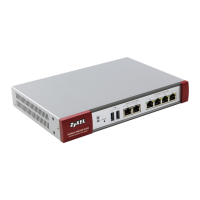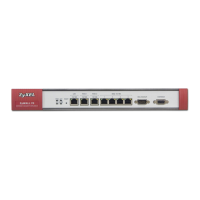Chapter 9 Interfaces
USG20(W)-VPN Series User’s Guide
149
9.3.1 Ethernet Edit
The Ethernet Edit screen lets you configure IP address assignment, interface parameters, RIP
settings, OSPF settings, DHCP settings, connectivity check, and MAC address settings. To access
this screen, click an Edit icon in the Ethernet Summary screen. (See Section 9.3 on page 147.)
The OPT interface’s Edit > Configuration screen is shown here as an example. The screens for
other interfaces are similar and contain a subset to the OPT interface screen’s fields.
Note: If you create IP address objects based on an interface’s IP address, subnet, or
gateway, the USG automatically updates every rule or setting that uses the object
whenever the interface’s IP address settings change. For example, if you change
the LAN’s IP address, the USG automatically updates the corresponding interface-
based, LAN subnet address object.
With RIP, you can use Ethernet interfaces to do the following things.
• Enable and disable RIP in the underlying physical port or port group.
• Select which direction(s) routing information is exchanged - The USG can receive routing
information, send routing information, or do both.
• Select which version of RIP to support in each direction - The USG supports RIP-1, RIP-2, and
both versions.
• Select the broadcasting method used by RIP-2 packets - The USG can use subnet broadcasting or
multicasting.
With OSPF, you can use Ethernet interfaces to do the following things.
• Enable and disable OSPF in the underlying physical port or port group.
• Select the area to which the interface belongs.
• Override the default link cost and authentication method for the selected area.
• Select in which direction(s) routing information is exchanged - The USG can receive routing
information, send routing information, or do both.
IP Address This field displays the current IP address of the interface. If the IP address is 0.0.0.0 (in
the IPv4 network) or :: (in the IPv6 network), the interface does not have an IP
address yet.
In the IPv4 network, this screen also shows whether the IP address is a static IP
address (STATIC) or dynamically assigned (DHCP). IP addresses are always static in
virtual interfaces.
In the IPv6 network, this screen also shows whether the IP address is a static IP
address (STATIC), link-local IP address (LINK LOCAL), dynamically assigned
(DHCP), or an IPv6 StateLess Address AutoConfiguration IP address (SLAAC). See
Section 9.1.2 on page 142 for more information about IPv6.
Mask This field displays the interface’s subnet mask in dot decimal notation.
Apply Click Apply to save your changes back to the USG.
Reset Click Reset to return the screen to its last-saved settings.
Table 63 Configuration > Network > Interface > Ethernet (continued)
LABEL DESCRIPTION

